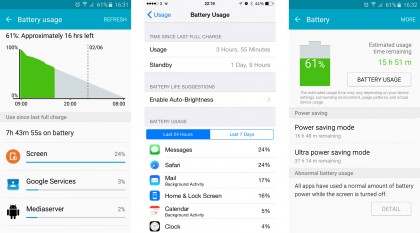As always, the iPhone is the best phone there is at not being used. That sounds like I'm having a sly dig at Apple here, but I'm really not.
The iPhone 6 is like its predecessors in its ability to only use power when it's actually being used. Leave it on airplane mode over night and the battery reading will barely budge. If you have a quiet day with few calls, messages, or other reasons to light up that screen, it'll last a decent spell.
During a fairly quiet weekend where the most intensive activity was the taking of the camera sample images for this piece, I got through a whole 24 hours (with the aforementioned overnight airplane mode) with 42 percent left in the tank.

This is despite the fact that the iPhone 6 only comes with an 1,810mAh battery. That's pretty small, at least by Android phone standards, but it goes to demonstrate how well balanced and efficient Apple's combination of hardware and software is.
The Samsung Galaxy S6, by contrast, comes with a 2550mAh battery, and yet that's widely seen a regrettable step back for the range.
Sure enough, the Galaxy S6's battery life is a disappointment. It simply didn't match up to the iPhone 6 in my day to day usage, as I'd get to the end of a day of light to moderate usage with around 20 percent left in the tank. This varied a fair amount, but that's a bit of a concern in itself.
If you use both phones heavily, you can still get through to bed time with the iPhone 6, while you'll probably need to top up before the the day is done with the Galaxy S6.
Get daily insight, inspiration and deals in your inbox
Sign up for breaking news, reviews, opinion, top tech deals, and more.

What's all the more curious is that the Galaxy S6 seems to have been optimised for handling media. In our 90 minute 720p video test, the Galaxy S6 (with display brightness cranked right up) ate through a mere 13 percent of its charge. That's very good going.
The iPhone 6, by contrast, chewed through 25 percent in the same test. Given its lower res display and power-sipping performance in general usage, such underperformance is a bit of a surprise, but perhaps sustained grunt work is where that difference in pure capacity comes in.